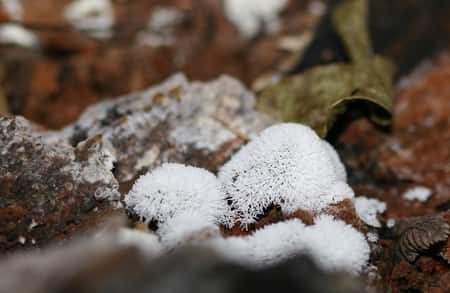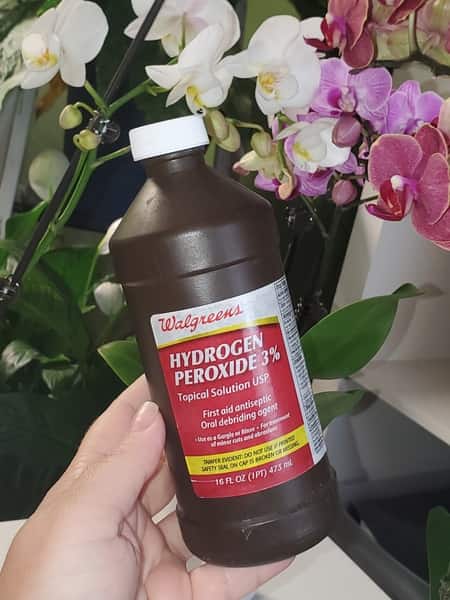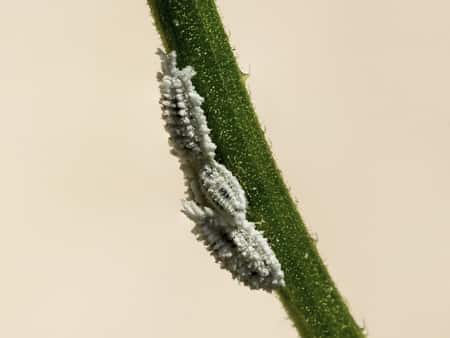Sometimes, there’s a lot more growing inside the potting medium than we would like to admit. Bacteria and fungi are more common than we realize. Yet inside the potting medium, white fuzz is never a good sign. A white, fuzzy cotton-like growth starts slow, usually in new medium right after an orchid repot. This powdery, spiderweb growth appears out of the blue. It looks like white cotton, but can also have projections like a web. This white fuzz in the orchid pot, whatever it is, needs to go.
The white fuzz that appears to be cotton inside the orchid potting medium can be either orchid mold, powdery mildew, or mealybugs. In time, these three components will prevent the growth of a healthy orchid and need to be treated immediately.
Some orchids have hairs on their roots and these can be mistaken for fungus. Orchids that are terrestrial or semi-terrestrial have this in common. Paphiopedilums, for example, will have fuzzy roots. Oncidiums will have somewhat fuzzy roots. They look like a thicker root covered in fungus, but that is their normal state. Other orchids have small hairs that will uniformly cover the extension of your root, looking like polka-dot patterns of white dots on green roots.
Before you unpot, treat with a pesticide, and get nervous about your “dying orchid”, do a quick search to see what the normal roots look like in your orchid. I only say this because I did this as a beginner. To my shame and embarrassment, the orchid was indeed fine.
In this article, you’ll learn to differentiate what white, fuzzy, cotton-like creature is on your orchid roots and inside the potting medium, how to eliminate it, and how to prevent it from coming back. In all the three possibilities, your orchid will not die immediately, but if left untreated over several months, there is no remedy to salvaging what’s left of the roots and leaves. Let’s look at these items one by one.


This Fungus is commonly called Orchid Mold or Snow Mold
1) Orchid Mold: A White, Powdery Fungus that Kills Orchids
The first thing I want to emphasize in this topic is yes, orchid mold will kill your orchid. I don’t know how many times I have read that old will not kill the orchid, but this is not true. If you leave the mold alone it might go away by itself, and yet, it might not. If left inside the pot unattended, the mold will eventually suffocate your orchid roots and kill your orchid.
Now that you know how serious orchid mold is, let’s get down to what matters: how it got into the pot. Orchid mold, sometimes called snow mold is a white fungus that looks like a spider web. It grows in-between the spaces in your potting medium and usually appears after a repot.
It is very common to see orchid mold growing in new terrarium setups, where the mold sprouts from nowhere. It’s frustrating as heck because everything I use is sterile (to the best of my ability) and mold still pops up. When this happens, it’s because the mold is on a cycle, and the new spores pop up quickly but later die down. The mold naturally goes away by itself.
You can leave the mold, keeping a careful and close eye on it, to see if it will die off by itself. Most often in terrariums, it will. In pots, it won’t. This is because there is not good ventilation in the pot, and the humidity stays more present for longer.
*P.S. When I talk about terrariums, they are always open terrariums, not closed-bottled terrariums. No orchid will survive in a closed terrarium.
This orchid fungus appears because, like all fungus, it like high humidity, low light, cold, and dark growing environments. White fungus, or Ptychogaster sp, appears during late autumn and early winter when the temperatures will drop and the orchid is still wet.
If you grow orchids indoors, then it’s probably the cool wind current that is coming through the window that will provoke the snow mold to grow.
How does orchid mold, or snow mold, kill the orchid? This spiderweb-like fungus forms a web that will repel water. It is so thick that you can peel it back, like sunburnt skin that peels in plaques.
Over time, if the web is thick enough, this cotton-structured fungus will not allow water to reach the orchid roots. The roots on your orchid will soon become dark gray or black, which we mistakenly think of as root rot.
The fungus does not eat the orchid roots but feeds on the dead decaying material inside your orchid pot. Without water, your roots will dehydrate and die. Then your orchid dies because no nutrients are being fed to your orchid.
Snow mold or orchid mold turns into a hydrophobic fabric that will not let water penetrate the orchid potting medium. No matter how much you water, the orchid bark is always dry. Even though the mold was attracted to an over-saturated medium, where water was abundant and probably occurred due to over-watering, that condition doesn’t stay that way.

2) Powdery Mildew on Orchid Roots: A White Sugary Mold
Mildew, common on orchid leaves, is one specific type of mold that grows on damp surfaces. It has a flatter spreading, unlike the spiderwebs that the orchid snow mold has. At least some molds are useful, like in the fabrication of the vaccine penicillin, or the yeast in bread, the making of cheese, and the production of tofu. Yet, mildew is useless. It has no use to use in day-to-day life or in the orchid pot.
Both mold and mildew have a distinct, dreadful smell that is extremely “visible” during a repot. If you can imagine a dark non-ventilated wine cellar that has had a water leak for over a month and the water sat there in the dark. This is what mold and mildew smell like.
It could be compared to damp, dirty socks, or old mushrooms. Another description is of decaying wood. This damp, dark, chilly, stale cellar is the perfect description of both the smell and the growing conditions of both mildew and mold.
You smell this because both orchid mold and mildew are reproduced by spores. The smell is literally the gases released by the mold where spores are traveling to infest other plants around it. This is why when you have one bad grapefruit in the bag, the others quickly get infested with greenish-black mold, even when they aren’t touching.
How to Treat Orchid Mold and White Mildew
There is another culprit that creates cotton-like fuzz in your potting medium which are mealybugs. Before I get into them, I thought it would be good to take a tangent and get talk about getting rid of orchid mold and orchid mildew first. At the end, I’ll head towards the mealybugs again.
It is extremely important to remove the orchid pot that has been infected with both mold and mildew to another location where the spores will not travel to other pots. There must be no way that the spores (which travel on wind currents) reach the pots next to it. There are specific ways to prevent and treat orchid mold and mildew infestations and it’s not hard as long as you follow the steps below.
A) Repot with a Medium that Drains Well
To eliminate both the mold and the mildew, you need to eliminate the growing conditions that brought it there in the first place. The first is dampness. Orchids love high humidity, but not being constantly damp inside the potting medium.
If you are using pure sphagnum moss, which retains tons of water and doesn’t dry out for a long time, then it might be good to consider a switch in potting medium. Change to something that retains water but drains faster, like a mix of sphagnum moss and orchid bark.
To know what orchid potting mix is right for your growing conditions, check out these two articles. The first one I wrote specifically for cymbidiums, but the description on the potting media will give you a good idea of how to choose the best one for your conditions. The second one is choosing the different types of potting mediums, a general overview.
B) Spray the Orchid Roots with a Fungicide
Even though you removed all the old potting medium in the first step, you still need to find a way to kill and spores that have attached to the remaining healthy roots. This can be done with a fungicide, like Physan 20 (Affiliate Link) or a product you can use at home. Whatever you use, an active ingredient that works well to eliminate orchid mold is called “alkyl dimethyl benzyl ammonium chloride”. Check your solution to see if it contains that compound.
or a product you can use at home. Whatever you use, an active ingredient that works well to eliminate orchid mold is called “alkyl dimethyl benzyl ammonium chloride”. Check your solution to see if it contains that compound.
If you don’t like the idea of using a fungicide, then you can use Hydrogen Peroxide. I wrote an entire article about the benefits and problems with using Hydrogen Peroxide, and I don’t use it anymore when I repot. Yet I still use Hydrogen Peroxide as a way to kill fungus and bacteria, so in this case, it is recommended.
Image Credit: © 2020 Orchideria. All Rights Reserved.

I have read (but I have not tried this personally) that you can use a 40% milk and 60% water solution to spray your orchids. Apply this in while the orchid gets light.
The proteins in the milk, be it skim or whole milk, will interact with the sunlight and kill the fungus growth. When I researched this method, there were no negative indications that this did not work nor that it left behind a distinct smell.
Since the proteins in the milk would magnify the sunlight, the mold and mildew would die off. This happens because both mold and mildew like to be in darker growing conditions and can’t stand direct sunlight. Well, your orchid leaf can’t either.
So the solution needs to be a week solution, where the milk is allowed to interact with the light but not burn the leaf.
This solution, where Physan 20, Hydrogen Peroxide, or milk, need to be reapplied every ten days or every two weeks. At least reapply twice, but the best recommendation is to reapply until you are positive no more mold is growing.
C) Adjust Your Temperatures to Eliminate Orchid Mold
Remember how the mold likes to live in cooler, damp places? If you have a heating pad, I suggest using it. The higher temperatures will eliminate the mold.
If you don’t eliminate the excess humidity, you might get green algae though. So make sure you are eliminating both the cool temperature and the excess humidity inside the pot. If you are curious about green algae, which is the very opposite of orchid mold, then this article I wrote is a good place to start.
When you raise the temperature especially during winter, the fungus doesn’t have the cooler conditions it likes. There is a small side note here: there are literally hundreds of thousands of fungi in the world—probably millions—and I’m sure that there will be someone who will protest saying that the high temperatures will aid in ore fungal growth. This is true of some fungus, but no powdery mildew nor snow mold, both of which are the top 2 fungal infections in orchids.(Source )
)
If you don’t have a heating pad that can be turned on during the winter months, my suggestion is this one (Affiliate Link).
 I have some reservations about the one I bought and placed them in this article about heating pads. Make sure you get one that fits your needs, and not just what I’m recommending (or not).
I have some reservations about the one I bought and placed them in this article about heating pads. Make sure you get one that fits your needs, and not just what I’m recommending (or not).
D) Orchid Mold is Eliminated With Adequate Airflow
I like the image of the dark, cool cellar because once again, it displays exactly how this mold grows. The air inside the cellar doesn’t flow. It’s trapped down inside this dark, dungeon-like room. The same happens inside the orchid pot where the media is too tightly packed, or when the air is not flowing.
Verify that your pots have slots, slits, holes, or anything that will allow proper airflow. Inside our homes, and especially my home office where I keep all my orchids, there is no wind. I have to keep the fan on during the day and night. It’s especially important to keep the fan on at night since that is when most of the “overwatered” pots have problems.
The fan on low will help the orchid dry out faster and provide air to reach the roots. This in itself will eliminate the production and growth of mold. When there is no airflow, the orchid sits inside a pool of soggy potting medium and invites fungus.
E) Isolate Your Orchid To Prevent Transmission of Orchid Mold
Remember that the orchid mold and powdery mildew grow and reproduce through spores? If you have a fan on, this aids in airflow but hinders orchid health in terms of the spreading of spores. These spores can easily “jump” from one orchid to another, as they travel on the wind.
For a month, while you are applying Physan 20 or any other fungicide of your choice, keep your orchid out of reach from your other household plants and your orchid collection. Keep it isolated until you are sure that no more spores are in your potting medium and all have been killed.
3) White Cotton-Like Insects Called Mealybugs
The third possibility of white, powder-like substance on your orchid could not be a fungus at all. It could be a tiny insect called mealybugs. Mealybugs are a common orchid problem and when they infest an orchid, it looks like cotton candy. I wrote an article about mealy bugs which you can read here, so I won’t repeat myself all again here.
The main thing you need to know about mealybugs is that they can be treated the same way as the orchid mold and the powdery mildew. The same applications apply, except for the milk. Use a fungicide like Physan 20, or rubbing alcohol to manually rub them off your orchid.
You will need to repot and use fresh medium, since mealybugs have horrible habits of hiding inside the nicks and crannies of the orchid bark.


Mealybugs are a Common Orchid Problem.
These are the 3 overall culprits of your orchid potting medium having white fuzz in it: orchid mold, orchid powdery mildew, or mealybug. In all these cases, the plant is stressed and needs to be helped so it can go on to produce a beautiful bloom.
Don’t Stop Learning!
If you want to be included in more information and get a 14-page fertilization guide, please sign up for my newsletter. I don’t spam, but send emails out bi-monthly with some curious topics of interest. If you want more information, click here to go to a specific page on this website where I explain it more in detail.

Also, if you are looking for an orchid journal to keep your notes specifically about orchid care, check out my 2 solutions for that on this page. If note-keeping isn’t your thing, then there is a free excel spreadsheet that you can download. Click here for more information on how to do that.
If you subscribe to my newsletter, I will send you a 14-page guide on the main tips of orchid fertilizer. It is downloadable and you can print it out on your computer. I designed the guide to double up as a coloring book, just to make it fun.
Below are the articles I mentioned during the course of this tutorial. I mention them here again because I always found it hard to go back and find the article I wanted to read after I was done.
–Best Potting Medium for Cymbidium
–Right and Wrong Potting Medium
– Should You Use Hydrogen Peroxide With Your Orchids?
–Green Algae in You Orchid Pot
–Mealybugs and How to Eliminate them
If you have found this article helpful, please comment below. It’s always great to interact with other orchid enthusiasts, be it a beginner level or more experienced. I by no means am an expert since there isn’t an orchid I can’t kill.
We are always learning on this path of orchid care and I certainly am learning tons of new information about how to grow orchids indoors, which is a new thing for me.
I wish you the best in your orchid care! Happy cultivating!


Question. We just found a whole bunch of fluffy, cottony, white mold (or something) all over the leaves of a couple of our orchid plants. We saw no sign of it on the roots. Could this be snow mold?
Hi Susan,
This probably isn’t mold since it’s on the leaves. Without a picture it’s hard to tell, but my first guess would be mealybugs or even spider mites. I have an article about mealy bugs here: https://orchideria.com/mealybugs-on-orchids/ I hope that helps.
-Amanda